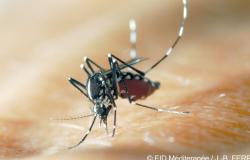THE James Webb Space Telescope NASA has obtained a new infrared image of the Horsehead Nebula, reaching unprecedented resolution. The horse’s head is one collapsing cloud of gas and dust about 1,300 light years away, inside the larger Orion Nebula. It is one of the best known and most observed regions of the Milky Way, given its suggestive shape and its fundamental role in the star formation brighter than our galaxy, but the new space telescope image allows us to study it in unprecedented detail structure and to obtain important information about your composition.
What the details of the JWST images of the Horsehead Nebula show
The Horsehead Nebula owes its name to the fact that its shape resembles – when viewed from Earth – the head of a horse seen in profile. It is illuminated by nearby stars and is opaque due to the dust present inside (about 1% of the mass of the nebula). In the new images from the James Webb Space Telescope, we cannot see this shape because we are only observing a tiny detail of the entire nebula, as we can see in this composition which also uses wider field images from other space telescopes (Euclid and Hubble).
Even at first glance, the level of detail that the James Webb Telescope can achieve is absolutely impressive. To give you an idea, the nebula extends over approximately 192,000 astronomical units (1 astronomical unit corresponds to the average distance between the Earth and the Sun, approximately 150 million km), and the images are capable of resolving details less than 40 astronomical units: very little compared to the distance of this object! What we are looking at is actually in false colorsbecause the Webb telescope collected this near-infrared image thanks to its camera NIRCam.
James Webb also has a room (MIRI) which observes in the mid-infrared and gave us another spectacular image of the tiny details of the nebula’s surface.

But what exactly are we looking at in these images? Dark nebulae like Horsehead are a key location for cloud formation new stars and new planets: the gases and dust they contain collapse under the effect of their own gravity, until they reach a density allowing the nuclear fusion of hydrogen and New “light” stars. Young stars are extremely bright and generate large amounts of energy and winds, ionizing the gas and “sweeping away” the dust around them.
Like the Pillars of Creation, Horsehead is a region of photodissociation, that is to say a “border” between the dark nebula and the surrounding gas ionized (i.e. separated from its electrons) by the newly formed stars, and its suggestive shape is due to the presence of heaps of denser, colder gases, where ultraviolet light struggles to penetrate. penetrate and star formation can continue undisturbed. This means that the gas that makes up the Horse’s Head is in turn destined to heat up and evaporate under the effect of the energy emitted by nearby stars, dispersing interstellar dust with it. In this case, it is expected that the Horse’s Head will be doomed to disappear by 5 million years (a wink in astronomical terms).
Why James Webb Images Matter
As Orion is the closest region of massive star formation to us, Horsehead has been observed in great detail with many telescopes sensitive to different frequencies of light radiation. It was notably one of the first objectives of the Euclid space telescope, launched in 2023. However, James Webb’s images are Unprecedented for their infrared resolution, obtained mainly thanks to the diameter of 6.5 meters of its main mirror, and the very sophisticated thermal shield which protects it from the Sun’s rays. The phenomena linked to cloud photodissociation occur in a very superficial layer of cloud. the Horse’s Head, which is why the high resolution of James Webb is necessary to observe these processes in detail. In particular, the light emitted by the nebula in the mid-infrared (visible in the MIRI image) comes mainly from the dust and organic molecules contained in the cloud, and therefore provides us with valuable information on its chemical composition. Knowing the composition of clouds is of great interest for understanding the processes of star formation brighter than our galaxy.








